
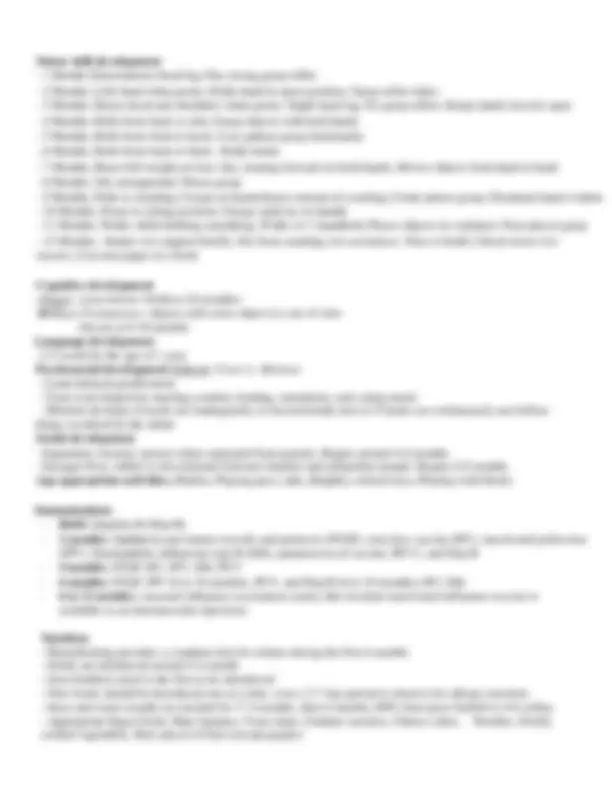
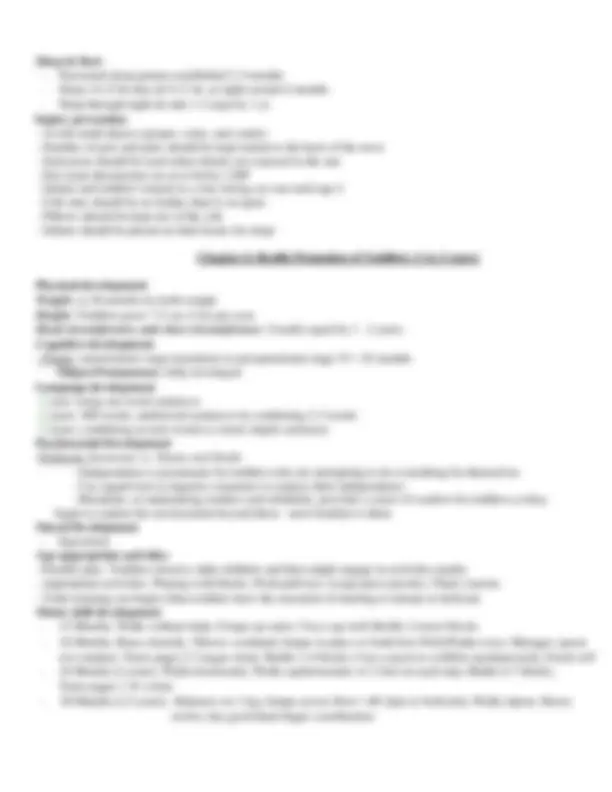
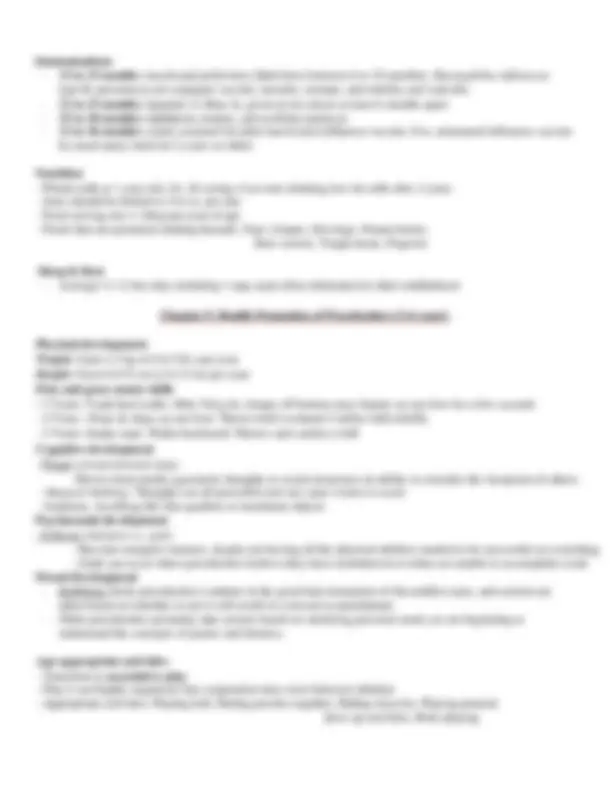
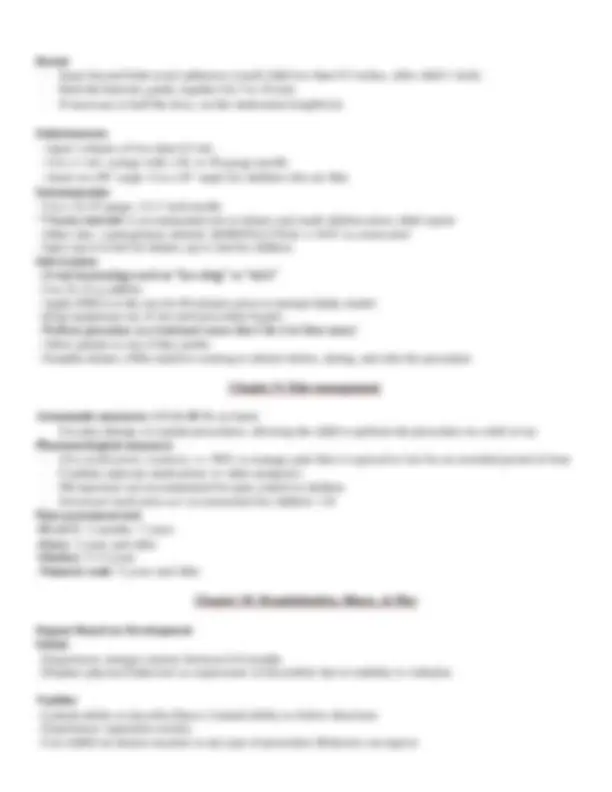
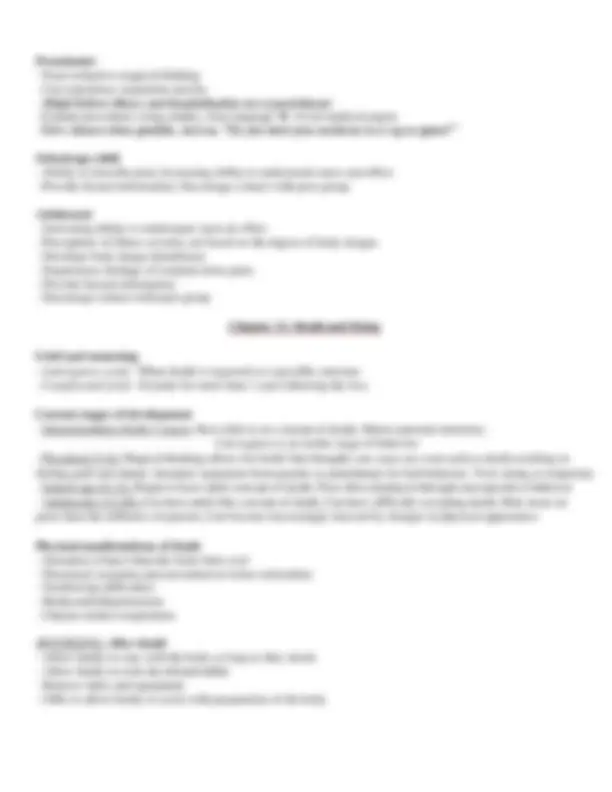
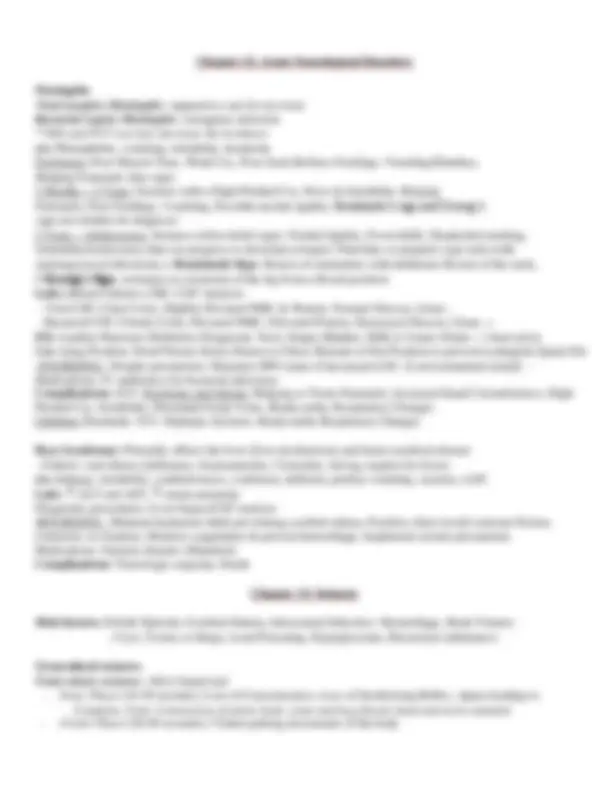
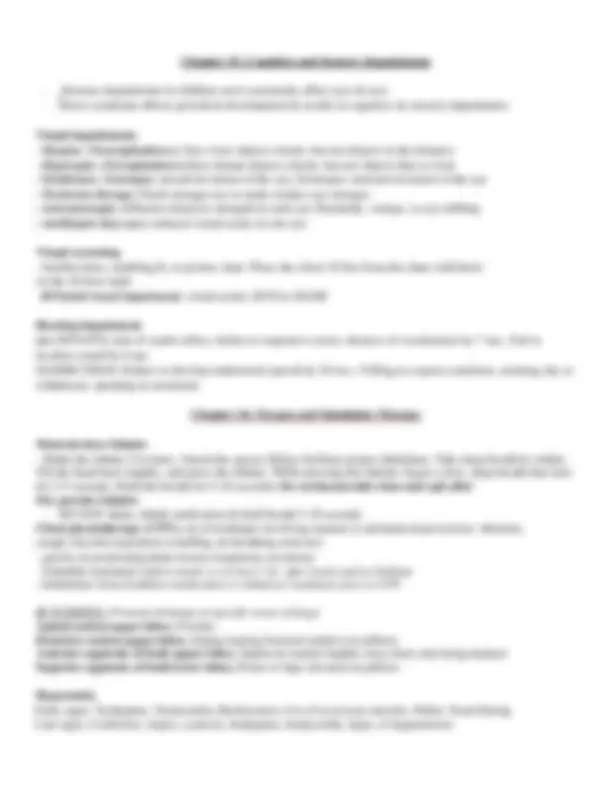
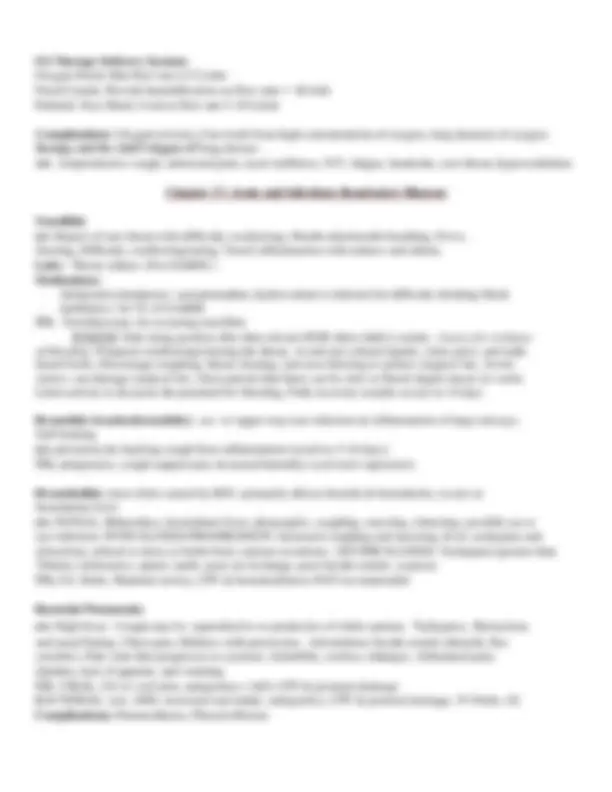
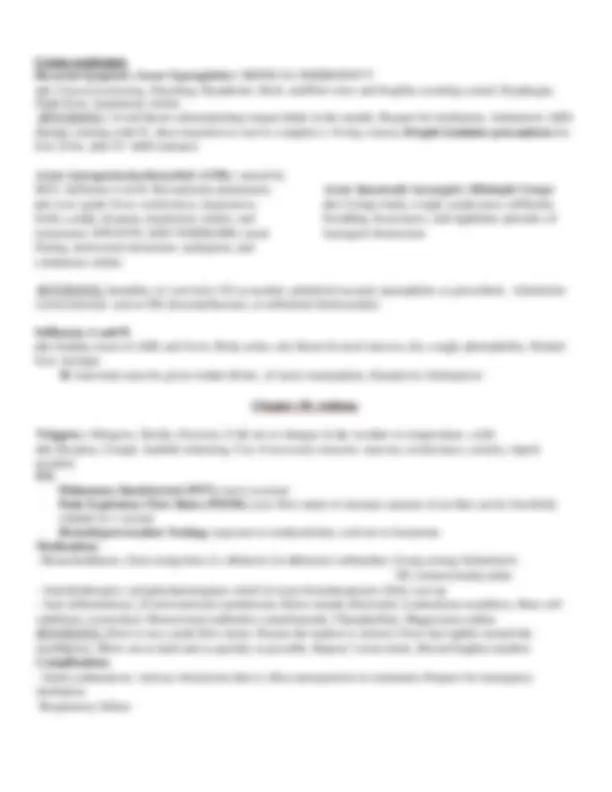
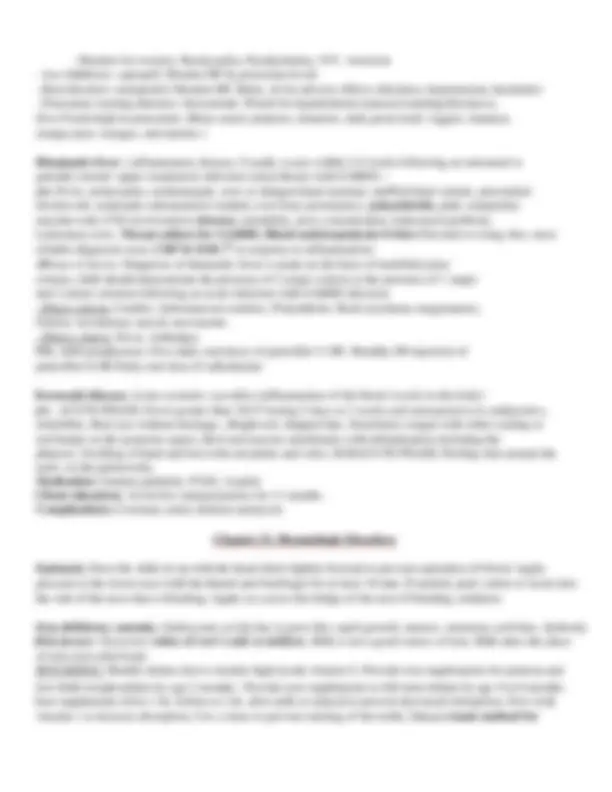
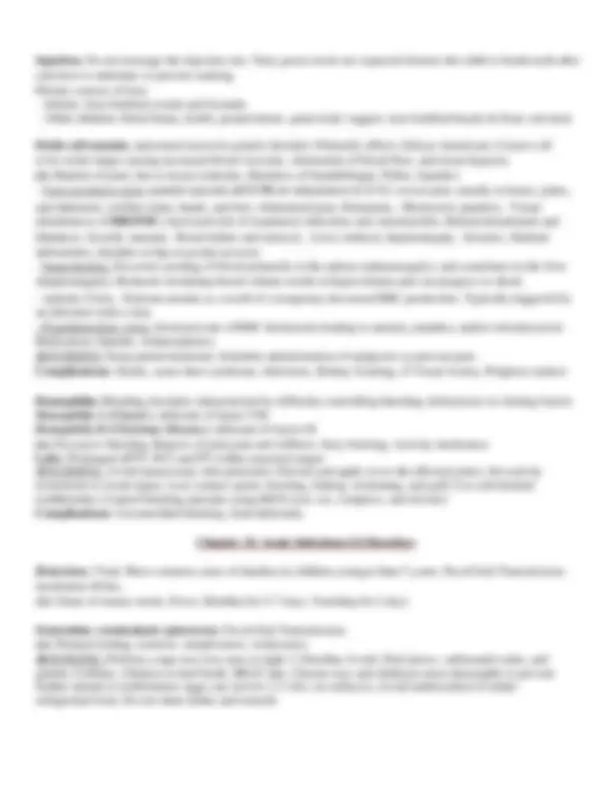
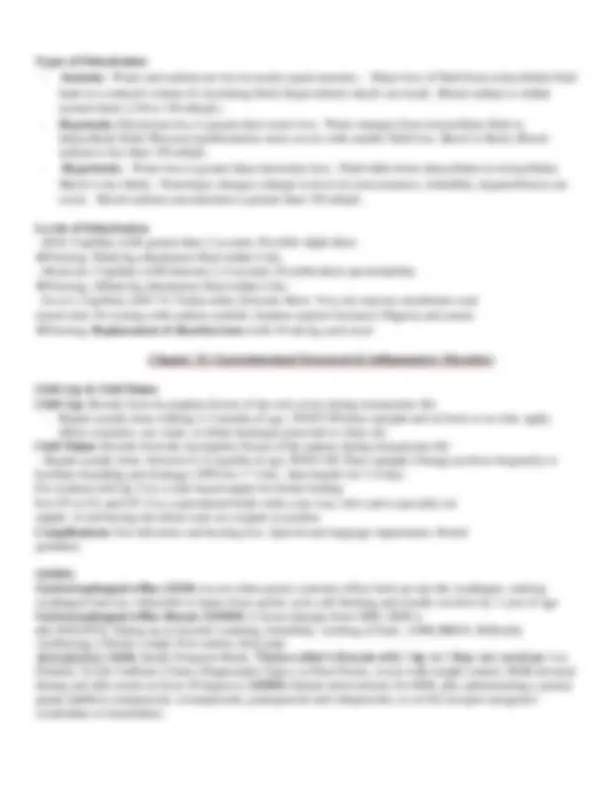
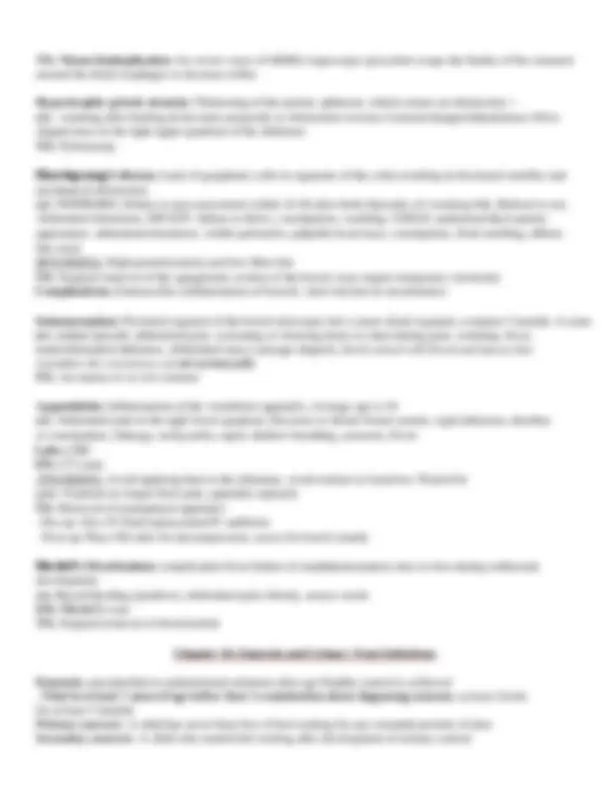
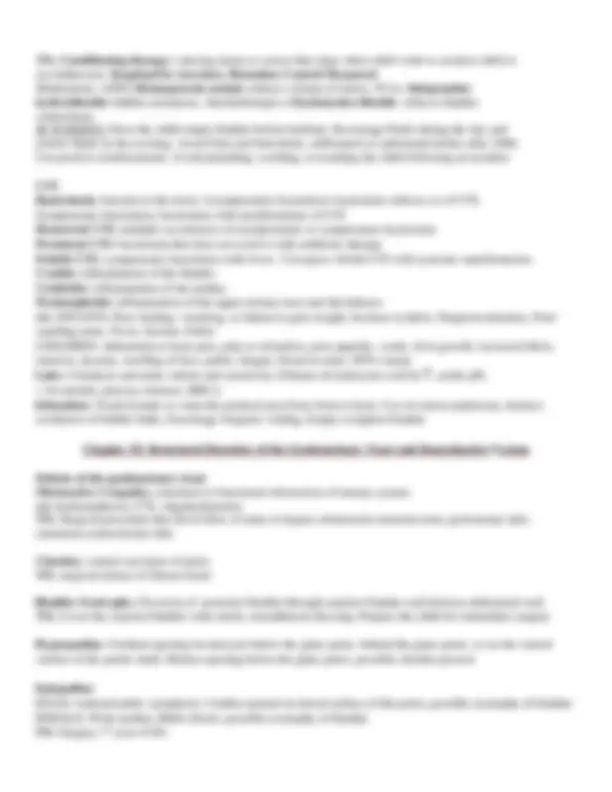
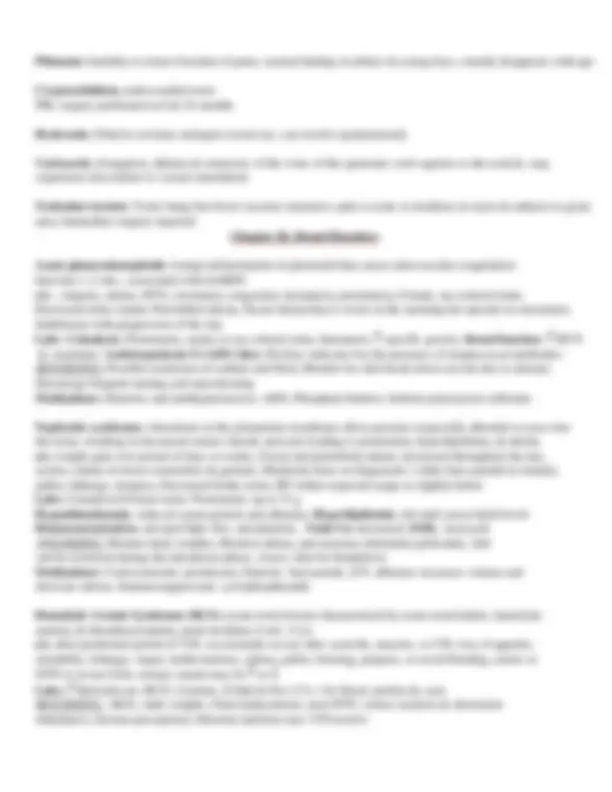
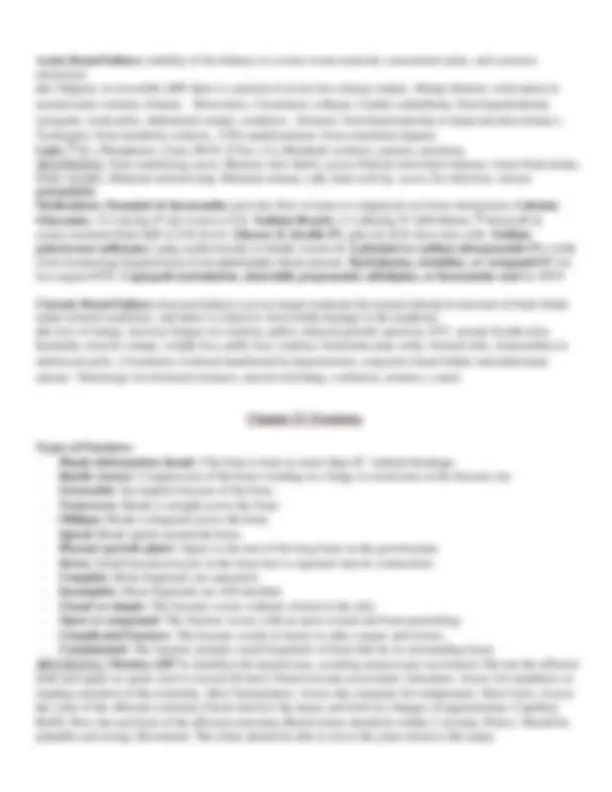
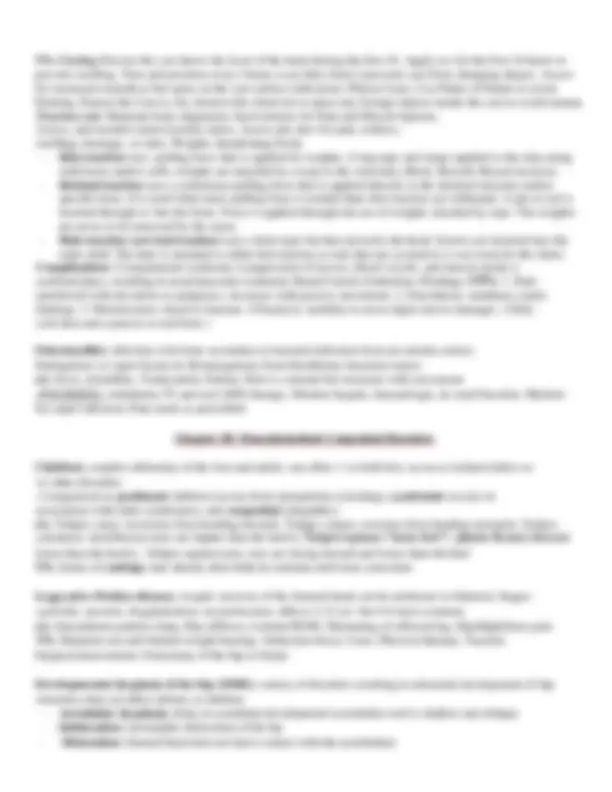
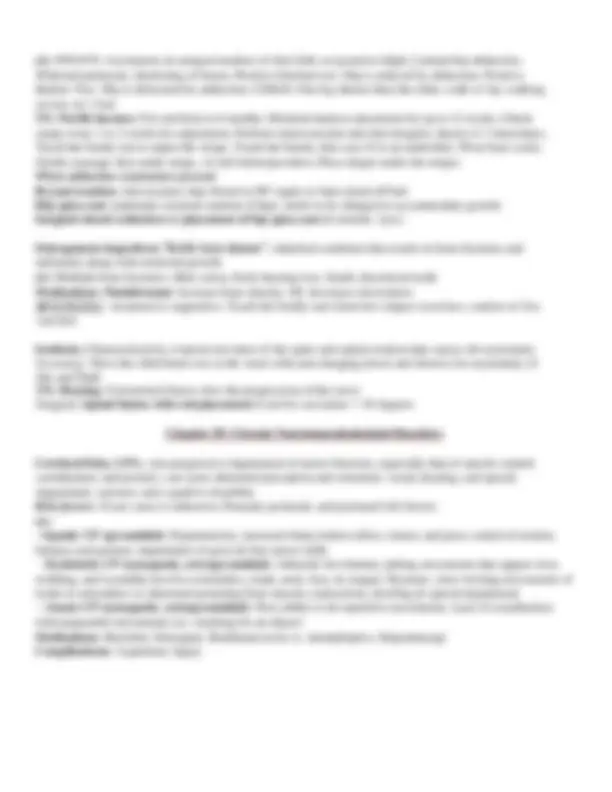
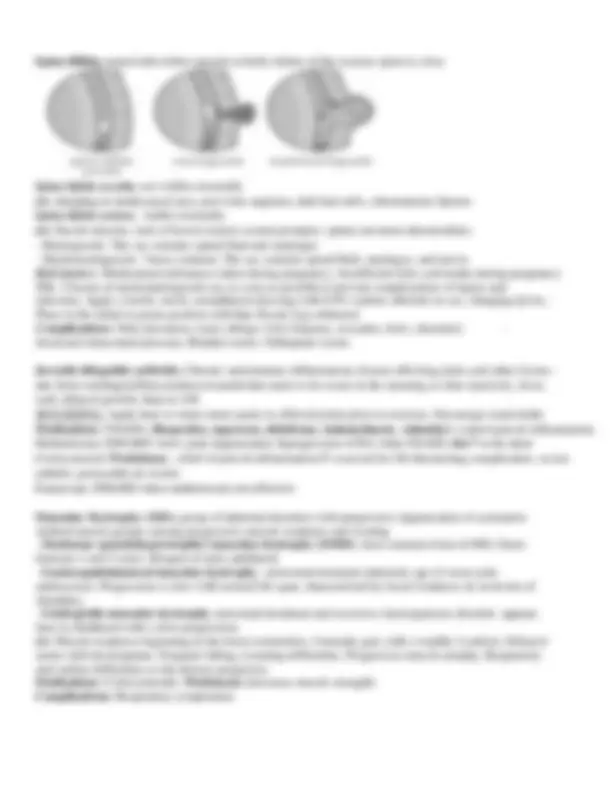
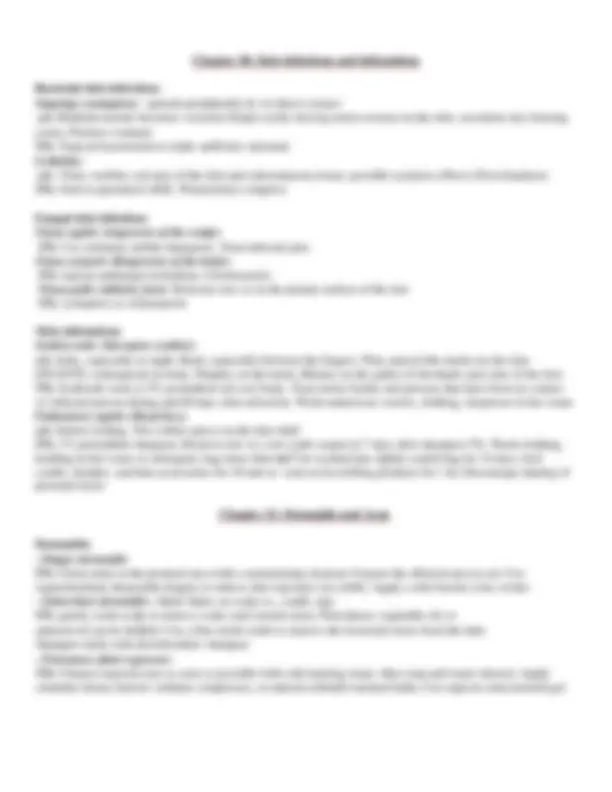
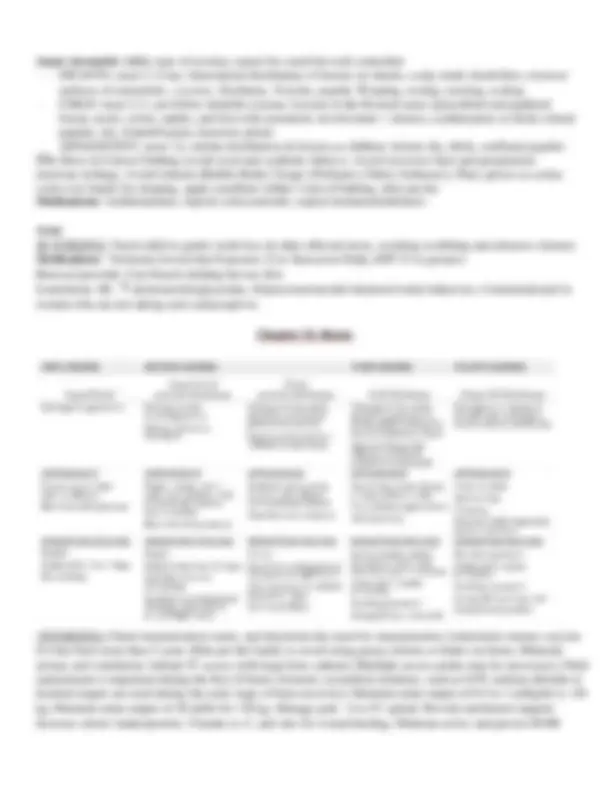
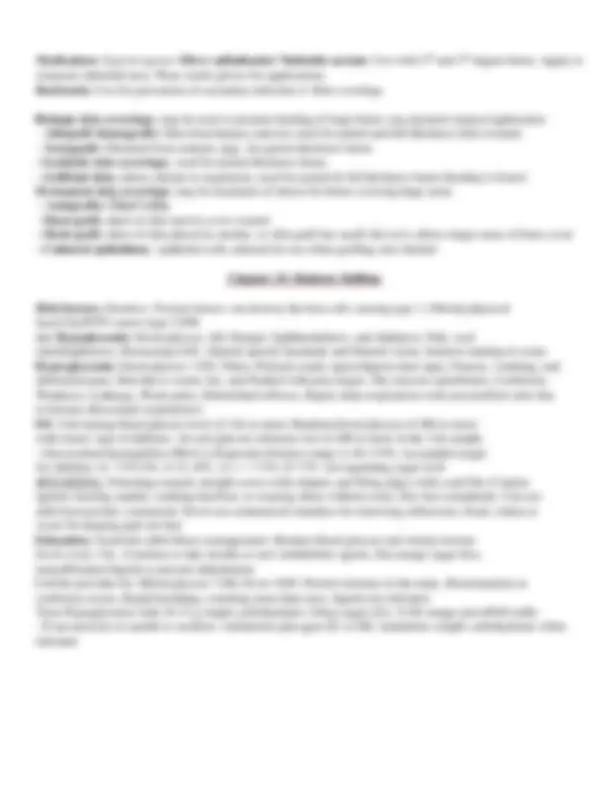
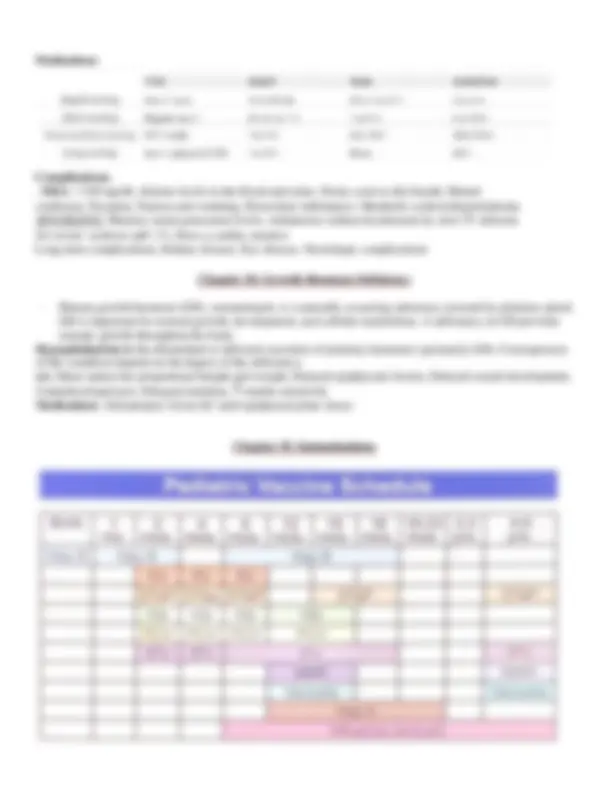
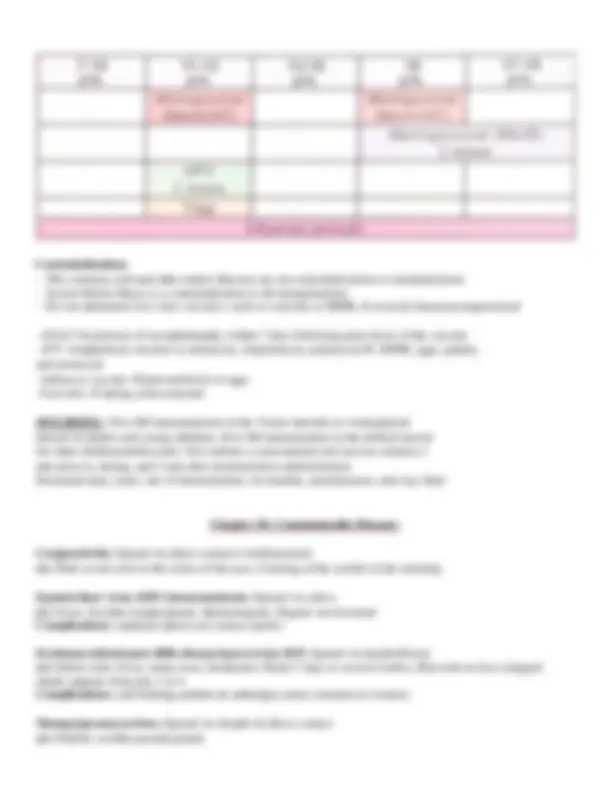
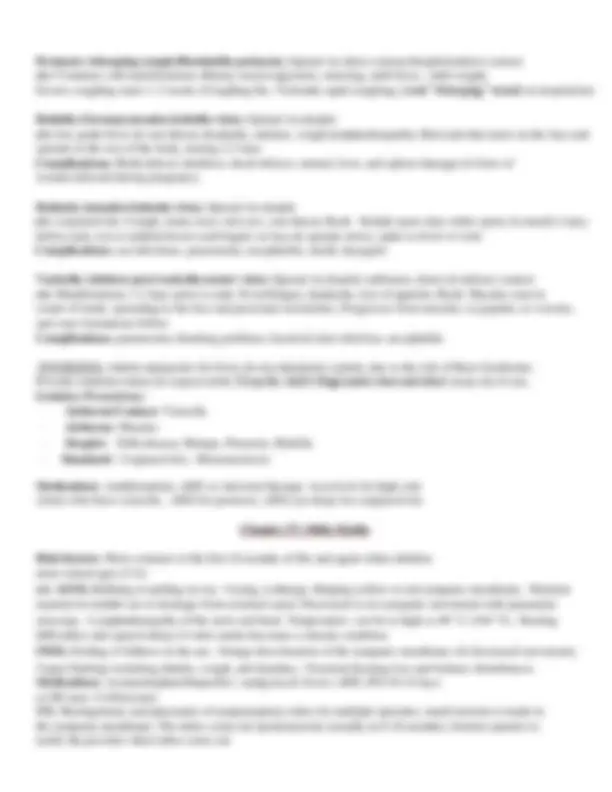
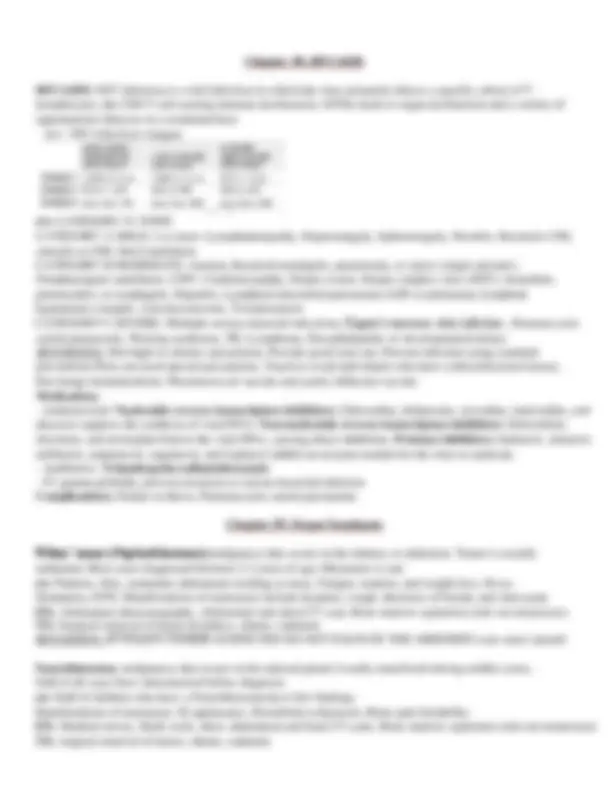
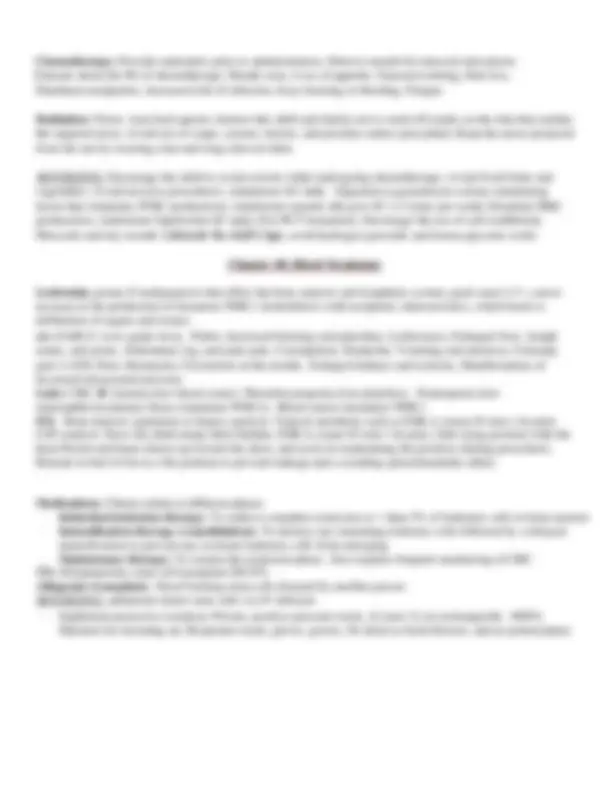
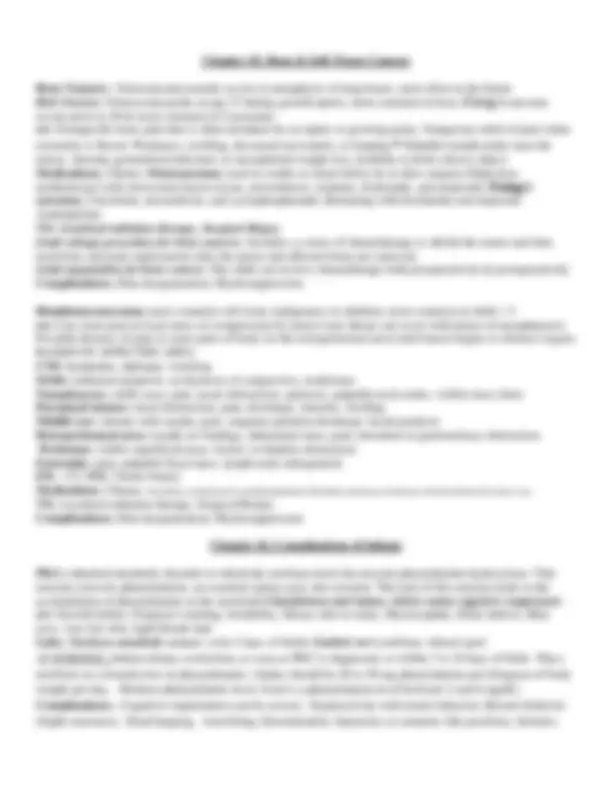
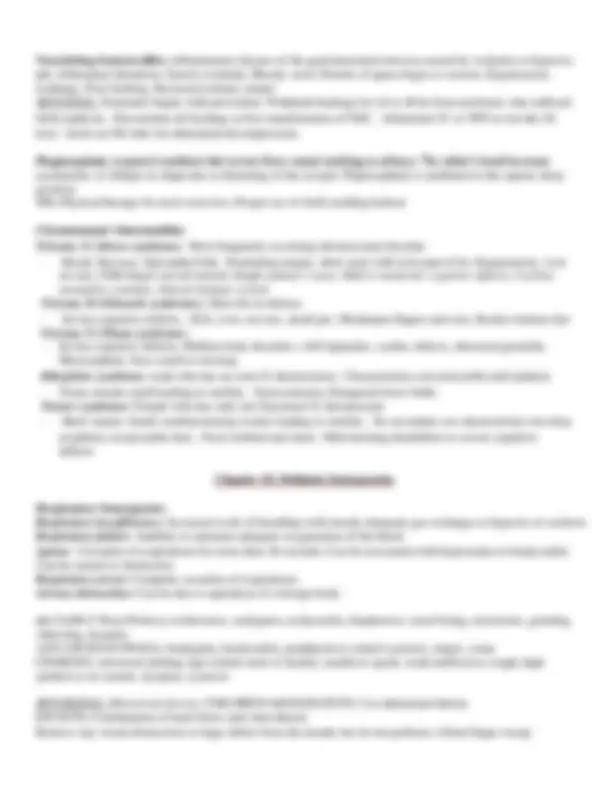
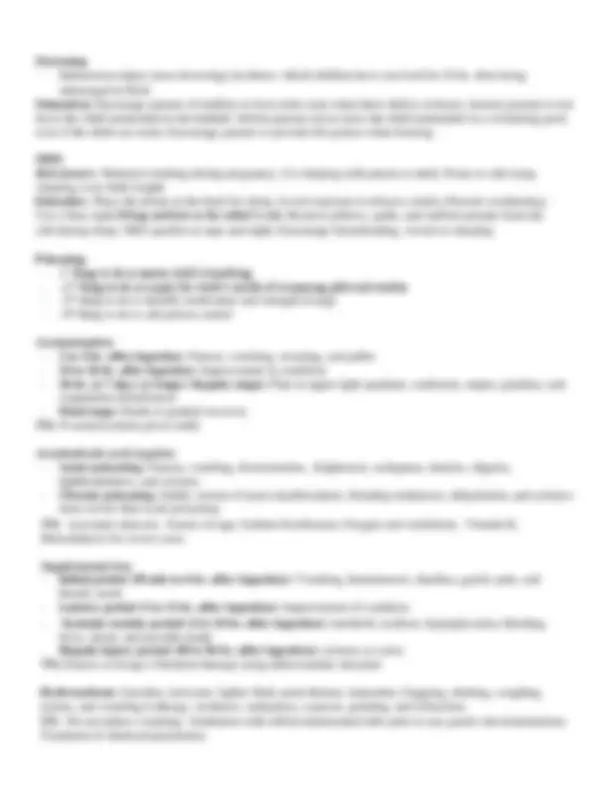
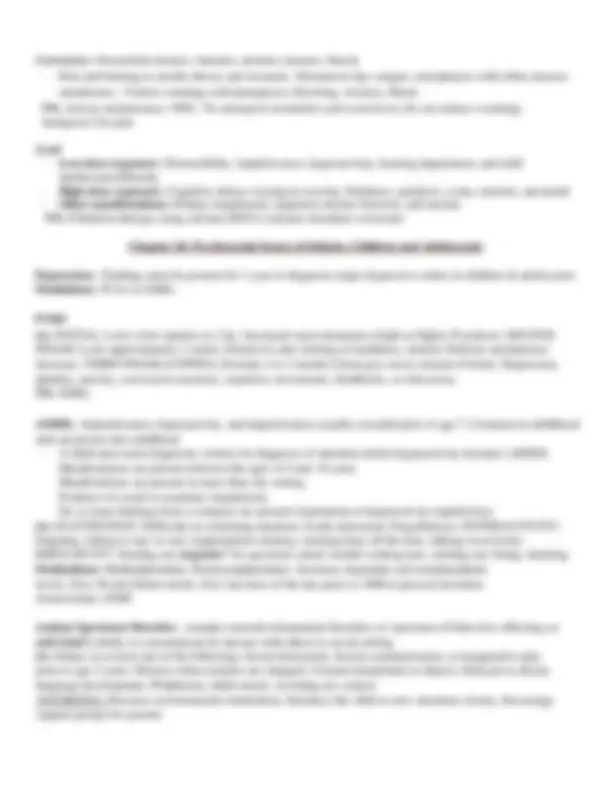


Study with the several resources on Docsity

Earn points by helping other students or get them with a premium plan


Prepare for your exams
Study with the several resources on Docsity

Earn points to download
Earn points by helping other students or get them with a premium plan
Community
Ask the community for help and clear up your study doubts
Discover the best universities in your country according to Docsity users
Free resources
Download our free guides on studying techniques, anxiety management strategies, and thesis advice from Docsity tutors
ATI testbanks. This was so helpful for me
Typology: Exams
1 / 39

This page cannot be seen from the preview
Don't miss anything!
































Pediatrics ATI CMS
Chapter 1: Family Centered Nursing Care
Parenting styles
- Dictatorial or authoritarian; Parents try to control the child’s behaviors and attitudes through
unquestioned rules and expectations
decisions
each rule setting; Parents negatively reinforce deviations from the rules
of his homework and chores
Family Theories
- Family Systems: Family viewed as whole system instead of individual family members; change w/ 1
member affects whole family
- Family Stress: Stress is inevitable - Developmental: Views families as small groups that interact with larger social system; emphasizes
similarities and consistencies in how families change
Chapter 2: Physical Assessment Findings
Vital signs: Usually all high except for BP
Temperature:
3 – 6 months 99.
1 year 99.
3 year 99.
5 years 98.
7 years 98.
9 – 11 years 98.
13 years 97.
Pulse:
NEWBORN (birth-2 days) 110 – 16 0/min
INFANT (2 days– 1 yr. ) 90 – 160 /min
TODDLER ( 1 - 3 years) 80 – 14 0/min
PRESCHOOLER ( 3 - 5 years) 70 – 12 0/min
SCHOOL AGE ( 6 - 12 years) 60 – 11 0/min
ADOLECENT ( 13 - 18 years) 50 – 100/min
Respirations:
NEWBORN (birth-2 days) 30 – 60/min
INFANT (2 days– 1 yr. ) 25 – 30/min
TODDLER (1- 3 years) 25 – 30/min
PRESCHOOLER (3 - 5 years) 20 – 25/min
SCHOOL AGE (6 - 12 years) 20 – 25/min
ADOLECENT (13 - 18 years) 16 – 20/min
Blood pressure:
Head
Teeth
teeth with 32 permanent teeth
Infant Reflexes
Stepping Birth to 4 weeks
Palmar Grasp Birth to 3 months
Tonic Neck Reflex (Fencer Position) Birth to 3 – 4 months
Sucking and Rooting Reflex Birth to 4 months
Moro Reflex (Fall backward) Birth to 4 months
Startle Reflex (Loud Noise) Birth to 4 months
Plantar Reflex Birth to 8 months
Babinski Reflex Birth to 1 year
Chapter 3: Health Promotion of Infants (2 days to 1 year)
Physical Development
Weight: gain 1.5 lb./month for 1
st
5 months Doubled by 5 months; Tripled by 12 months
Height: 2.5 cm (1 in)/ month for the first 6 months
Length: Increases by 50% by 12 months
Head Circumference: Increases 2 cm/month for 1
st
3 months; 1 cm/month from 4-6 months
& 0.5 cm/month during 6 months- 1 yr.
Dentition: First teeth erupt between 6-10 months; 6-8 teeth should erupt by end of year 1
Sleep & Rest
Injury prevention
Chapter 4: Health Promotion of Toddlers (1 to 3 years)
Physical development
Weight: at 30 months 4x birth weight
Height: Toddlers grow 7.5 cm (3 in) per year
Head circumference and chest circumference : Usually equal by 1 - 2 years
Cognitive development
Language development
Psychosocial Development
- Erickson; Autonomy vs. Shame and Doubt - Independence is paramount for toddlers who are attempting to do everything for themselves - Use negativism or negative responses to express their independence - Ritualism, or maintaining routines and reliability, provides a sense of comfort for toddlers as they
begin to explore the environment beyond those most familiar to them
Moral Development
Age appropriate activities
Motor skill development
w/o rotation; Turns pages 2-3 pages /time; Builds 3-4 blocks; Uses crayon to scribble spontaneously; Feeds self
Turns pages 1 @ a time
circles; has good hand-finger coordination
Immunizations
type B; pneumococcal conjugate vaccine; measles, mumps, and rubella; and varicella
by nasal spray (must be 2 years or older)
Nutrition
Raw carrots, Tough meats, Popcorn
Sleep & Rest
Chapter 5: Health Promotion of Preschoolers (3-6 years)
Physical development
Weight: Gain 2-3 kg (4.5-6.5 lb.) per year
Height: Grow 6.9-9 cm (2.4-3.5 in) per year
Fine and gross motor skills
- 3 Years; Toe& heel walks; Rids Tricycle; Jumps off bottom step; Stands on one foot for a few seconds
Cognitive development
Psychosocial development
Moral Development
taken based on whether or not it will result in a reward or punishment.
understand the concepts of justice and fairness.
Age appropriate activities
dress up activities, Role-playing
Chapter 7: Health Promotion of Adolescents (12 to 20 years)
Physical development
In girls, sexual maturation occurs in the following order:
In boys, sexual maturation occurs in the following order:
Cognitive development
Psychosocial development
Age-appropriate activities; Nonviolent videogames, Nonviolent music, Sports, Caring for pet, Reading
Immunizations
by nasal spray. Recommendation can be season-specific.
ages 13 and 15 years; booster dose not needed if the first dose is received at age 16 or older.
Health Screenings: Scoliosis screenings should continue during adolescent years
Chapter 8: Safe Medication Administration
Oral
feeding, & the medication can alter the taste of the formula
Otic
Rectal
Subcutaneous
- Inject volumes of less than 0.5 mL. - Use a 1 mL syringe with a 26- to 30-gauge needle. - Insert at a 90° angle. Use a 45° angle for children who are thin.
Intramuscular
** Vastus lateralis is recommended site in infants and small children place child supine
Intravenous
Chapter 9: Pain management
Atraumatic measures; GOAL Do no harm
Pharmacological measures
Pain assessment tool
- FLACC : 2 months- 7 years - Faces : 3 years and older - Oucher: 3 - 13 years
Chapter 10: Hospitalization, Illness, & Play
Impact Based on Development
Infant
Toddler
Chapter 12: Acute Neurological Disorders
Meningitis
Viral (aseptic) Meningitis: supportive care for recovery
Bacterial (septic) Meningitis : contagious infection
** Hib and PCV vaccines decrease the incidence
s/s; Photophobia, vomiting, irritability, headache
Newborns: Poor Muscle Tone, Weak Cry, Poor Suck-Refuses Feedings, Vomiting/Diarrhea,
Bulging Fontanels (late sign)
3 Months – 2 Years: Seizures with a High-Pitched Cry, Fever & Irritability, Bulging
Fontanels, Poor Feedings, Vomiting, Possible nuchal rigidity, Brudzinski’s sign and Kernig’s
sign not reliable for diagnosis
2 Years – Adolescence: Seizures (often initial sign), Nuchal rigidity, Fever/chills, Headache/vomiting,
Irritability/restlessness that can progress to drowsiness/stupor, Petechiae or purpuric type rash (with
meningococcal infection ), + Brudzinski Sign : flexion of extremities with deliberate flexion of the neck ,
+ Kernig’s Sign : resistance to extension of the leg from a flexed position
Labs; Blood Cultures; CBC; CSF Analysis
DX: Lumbar Puncture (Definitive Diagnostic Test); Empty Bladder, EMLA Cream 45min – 1 - hour prior,
Side-lying Position, Head Flexed, Knees Drawn to Chest; Remain in Flat Position to prevent Leakage& Spinal HA
NURSING:: Droplet precautions; Maintain NPO status if decreased LOC; environmental stimuli -
Medications: IV antibiotics for bacterial infections
Complications: ICP : Newborns and Infants; Bulging or Tense Fontanels, Increased Head Circumference, High-
Pitched Cry, Irritability, Distended Scalp Veins, Bradycardia, Respiratory Changes
Children; Headache, N/V, Diplopia, Seizures, Bradycardia Respiratory Changes
Reye Syndrome: Primarily affects the liver (liver dysfunction) and brain (cerebral edema)
s/s; lethargy, irritability, combativeness, confusion, delirium, profuse vomiting, seizures, LOC
Labs : ALT and AST, serum ammonia
Diagnostic procedures: Liver biopsy/CSF analysis
NURSING: Maintain hydration while preventing cerebral edema, Position client (avoid extreme flexion,
extension, or rotation), Monitor coagulation & prevent hemorrhage, Implement seizure precautions
Medications: Osmotic diuretic (Mannitol)
Complications: Neurologic sequalae, Death
Chapter 13: Seizures
Risk factors; Febrile Episode, Cerebral Edema, Intracranial Infection / Hemorrhage, Brain Tumors
/ Cyst, Toxins or Drugs, Lead Poisoning, Hypoglycemia, Electrolyte imbalances
Generalized seizures
Tonic-clonic seizures: AKA Grand mal
Cyanosis; Tonic Contraction of entire body: arms and legs flexed, head and neck extended
the seizure
Absence seizure; AKA petit mal or lapses; Onset between 4 – 12 years and ceases by teenage yrs.
Resembles daydreaming or Inattentiveness, Can drop items being held, but the child seldom falls
Myoclonic seizure : Brief contraction of muscle or groups of muscle; No postictal state ; can involve only face
& trunk or one or more extremities; might not lose consciousness
Atonic or akinetic seizure AKA “drop attacks ”; Onset 2-5; Muscle tone is lost for a few seconds often causes fall;
period of confusion follows
DX: - EEG Abstain from caffeine for several hours prior to the procedure; Wash hair (no oils or sprays)
before and after the procedure to remove electrode gel
NURSING: Initiate Seizure Precautions:
Medications
Complications
which the client does not enter a Postictal Phase
NURSING: Maintain Airway, Administer oxygen, IV access
Chapter 15: Cognitive and Sensory Impairments
Visual impairments
Visual screening
on the 10-foot mark
Partial visual impairment; visual acuity 20/70 to 20/
Hearing impairment
s/s; INFANTS; lack of startle reflex, failure to respond to noise, absence of vocalization by 7 mo., Fail to
localize sound by 6 mo.
OLDER CHILD: Failure to develop understood speech by 24 mo.; Yelling to express emotions; seeming shy or
withdrawn; speaking in monotone
Chapter 16: Oxygen and Inhalation Therapy
Metered-dose Inhaler
Tilt the head back slightly, and press the inhaler, While pressing the inhaler, begin a slow, deep breath that lasts
for 3-5 seconds, Hold the breath for 5-10 seconds; for corticosteroids rinse and spit after
Dry powder Inhaler
Chest physiotherapy (CPT); set of technique involving manual or mechanical percussion, vibration,
cough, forceful expiration or huffing, & breathing exercises
NURSING; Promote drainage of specific areas of lungs
Apical section upper lobes; Fowlers
Posterior section upper lobes; Sitting leaning forward curled over pillows
Anterior segments of both upper lobes; Supine & rotated slightly away from side being drained
Superior segments of both lower lobes; Prone w/ hips elevated on pillows
Hypoxemia
Early signs: Tachypnea, Tachycardia, Restlessness, Use of accessory muscles, Pallor, Nasal flaring
Late signs; Confusion, stupor, cyanosis, bradypnea, bradycardia, hypo, or hypertension
O2 Therapy Delivery Systems
Oxygen Hood; Min flow rate 4- 5 L/min
Nasal Canula; Provide humidification on flow rates > 4L/min
Pediatric Face Mask; Used at flow rate 5-10 L/min
Complications: Oxygen toxicity; Can result from high concentrations of oxygen, long duration of oxygen
therapy, and the child’s degree of lung disease
s/s: nonproductive cough, substernal pain, nasal stuffiness, N/V, fatigue, headache, sore throat, hypoventilation
Chapter 17: Acute and Infectious Respiratory Illnesses
Tonsillitis
s/s: Report of sore throat with difficulty swallowing, Mouth odor/mouth breathing, Fever,
Snoring, Difficulty swallowing/eating, Tonsil inflammation with redness and edema
Labs: Throat culture: (For GABHS )
Medications:
TX: Tonsillectomy: for recurring tonsillitis
POSTOP; Side-lying position after then elevate HOB when child is awake ; Assess for evidence
of bleeding: Frequent swallowing/clearing the throat, Avoid red-colored liquids, citrus juice, and milk-
based foods, Discourage coughing, throat clearing, and nose blowing to protect surgical site, Avoid
straws: can damage surgical site, Alert parents that there can be clots or blood-tinged mucus in vomit,
Limit activity to decrease the potential for bleeding, Fully recovery usually occurs in 14 days
Bronchitis (tracheobronchitis); ass. w/ upper resp tract infection & inflammation of large airways;
Self limiting
s/s; persistent dry hacking cough from inflammation (resolves 5-10 days)
TX; antipyretics, cough suppressant, increased humidity (cool mist vaporizers)
Bronchiolitis; most often caused by RSV; primarily affects bronchi & bronchioles; occurs at
bronchiolar level
s/s: INITIAL: Rhinorrhea, intermittent fever, pharyngitis, coughing, sneezing, wheezing, possible ear or
eye infection; WITH ILLNESS PROGRESSION: Increased coughing and sneezing, fever, tachypnea and
retractions, refusal to nurse or bottle feed, copious secretions ; SEVERE ILLNESS: Tachypnea (greater than
70/min), listlessness, apneic spells, poor air exchange, poor breath sounds, cyanosis
TX; O2, fluids, Maintain airway, CPT & bronchodilators NOT recommended
Bacterial Pneumonia
s/s: High fever; Cough may be unproductive or productive of white sputum, Tachypnea, Retractions
and nasal flaring, Chest pain, Dullness with percussion, Adventitious breath sounds (rhonchi, fine
crackles), Pale color that progresses to cyanosis, Irritability, restless, lethargic, Abdominal pain,
diarrhea, lack of appetite, and vomiting
TX: VIRAL; O2 w/ cool mist, antipyretics, I &O, CPT & postural drainage
BACTERIAL; rest, ABX, increased oral intake, antipyretics, CPT & postural drainage, IV fluids, O
Complications; Pneumothorax, Pleural effusion
Chapter 19: Cystic Fibrosis
Cystic fibrosis; Both biological parents carry the recessive trait for CF
leads to mechanical obstruction of organs
s/s: EARLY; Wheezing, rhonchi, Dry, nonproductive cough; Increased involvement: Dyspnea,
Paroxysmal cough, Obstructive emphysema, and atelectasis on chest x-ray; ADVANCED: Cyanosis,
Barrel-shaped chest, Clubbing of fingers and toes
GI : Large, frothy, bulky, foul-smelling stools (steatorrhea), Failure to gain weight or weight loss, Delayed
growth patterns, Distended abdomen, Thin arms and legs, Deficiency of fat-soluble vitamins (Vitamin A,D,E,K)
SKIN; Sweat, tears, and saliva having high content of sodium and chloride
DX: Sweat chloride test (most definitive) Chloride > 40for infants < 3 mo & > 60 for all others; Sodium > 90
NURSING ; CPT, High protein/calorie, Give pancreatic enzymes within 30 min of eating a
meal or snack, Multivitamin A,D,E,and K
Medications
Chapter 20: Cardiovascular Disorders
Defects that INCREASE Pulmonary Blood Flow ; (left-to-right shunt)
causing mixing of blood; Murmur (machine hum), Bounding pulses
Defects that DECREASE Pulmonary Blood Flow
Cyanosis, dyspnea, tachycardia; Older children: Hypoxemia, clubbing of fingers
ventricular septal defect (PROV); Cyanosis at birth: progressive cyanosis over the first year of life;
Systolic murmur; Episodes of acute cyanosis and hypoxia (blue or “Tet” spells)
Obstructive Defects
obstruction of blood flow from the ventricles; Systolic ejection murmur
feeding tolerance; CHILDREN: Intolerance to exercise, dizziness, chest pain, possible ejection murmur
Elevated blood pressure in the arms, Bounding pulses in the upper extremities, Decreased blood pressure in the
lower extremities, Cool skin of lower extremities, Weak or absent femoral pulses
Mixed defects
- Transportation of the great arteries; aorta connected to the right ventricle instead of left & pulmonary
artery is connected to the left ventricle instead of right; Severe to less cyanosis depending on the size
of the associated defect
- Truncus arteriosus: Failure of septum formation, resulting in a single vessel that comes off of the
ventricles; Murmur, variable cyanosis, Lethargy, Fatigue, Poor feeding
- Hypoplastic left heart syndrome : Left side of the heart is underdeveloped; Lethargy/cyanosis, cold hands & feet
Pulmonary Artery HTN (PAH); high BP in arteries of the lungs; progressive & fatal; no cure
s/s: Dyspnea w/ exercise; Chest pain; Syncope
Infective (Bacterial) Endocarditis; Infection of inner lining of heart & valves, can enter bloodstream;
caused by Streptococcus viridians, Candida albicans, Staphylococcus aureus
s/s: Fever, malaise, new murmur, myalgia, arthralgias, diaphoresis, weight loss, splinter hemorrhages
under fingernails; NEONATES: feeding problems, respiratory distress, tachycardia, septicemia
NURSING: Counsel the family of high-risk children about the need for prophylactic antibiotics prior to
dental and surgical procedures
TX: ABX parenterally for extended period of time (2- 8 wks.)
Cardiomyopathy; abnormities of myocardium that interfere w/ ability to contract effectively;
can lead to HF
Classifications
mass lead t abnormal diastolic function; Restrictive ; rare, prevents filling of ventricle & causes decrease
in diastolic volume
s/s: tachycardia, dysrhythmias, dyspnea, hepatosplenomegaly, fatigue & poor growth
Shock
Cardiogenic shock; results from impaired cardiac function that leads to decrease in CO
Anaphylactic Shock
s/s: Dyspnea, Breath sounds with crackles, Grunting, Hypotension, Tachycardia, Weak peripheral pulses
Impaired myocardial function : Sweating, tachycardia, fatigue, pallor, cool extremities with weak pulses,
hypotension, gallop rhythm, cardiomegaly
Pulmonary congestion : Tachypnea, dyspnea, retractions, nasal flaring, grunting, wheezing, cyanosis, cough,
orthopnea, exercise intolerance
Systemic venous congestion: Hepatomegaly, peripheral edema, ascites, neck vein distention, periorbital
edema, weight gain
DX: Cardiac catherization
NURSING: Check for allergies to iodine or shellfish, Provide for NPO status 4- 6 hr. prior, Locate, and mark
the Dorsalis pedis and posterior tibial pulses on both extremities, Prevent bleeding by maintaining the affected
extremity in a straight position for 4- 8 hr. ; Limit activity for 24 hrs.
Medications
injection , Do not massage the injection site; Tarry green stools are expected Instruct the child to brush teeth after
oral dose to minimize or prevent staining
Dietary sources of iron:
Sickle cell anemia; autosomal recessive genetic disorder; Primarily affects African Americans; Causes cell
to be sickle shape causing increased blood viscosity, obstruction of blood flow, and tissue hypoxia
s/s: Reports of pain: due to tissue ischemia, Shortness of breath/fatigue, Pallor, Jaundice
and abdomen, swollen joints, hands, and feet, Abdominal pain, Hematuria, Obstructive jaundice, Visual
disturbances; CHRONIC; Increased risk of respiratory infections and osteomyelitis, Retinal detachment and
blindness, Systolic murmur, Renal failure and enuresis, Liver cirrhosis; hepatomegaly, Seizures, Skeletal
deformities; shoulder or hip avascular necrosis
(hepatomegaly); Reduced circulating blood volume results in hypovolemia and can progress to shock
an infection with a virus
Medication; Opioids, Antineoplastics
NURSING: Keep patient hydrated, Schedule administration of analgesics to prevent pain
Complications: Stroke, acute chest syndrome, Infections, Kidney Scarring, Visual Acuity, Priapism (males)
Hemophilia; Bleeding disorders characterized by difficulty controlling bleeding; deficiencies in clotting factors
Hemophilia A (Classic): deficient of factor VIII
Hemophilia B (Christmas Disease): deficient of factor IX
s/s; Excessive bleeding, Reports of joint pain and stiffness, Easy bruising, Activity intolerance
Labs: Prolonged aPTT; PLT and PT within expected ranges
NURSING: Avoid unnecessary skin punctures; Elevate and apply ice to the affected joints; Set activity
restrictions to avoid injury; Low-contact sports: bowling, fishing, swimming, and golf; Use soft-bristled
toothbrushes; Control bleeding episodes using RICE (rest, ice, compress, and elevate)
Complications: Uncontrolled bleeding, Joint deformity
Chapter 22: Acute Infectious GI Disorders
Rotavirus; Viral; Most common cause of diarrhea in children younger than 5 years; Fecal-Oral Transmission;
Incubation 48 hrs.
s/s: Onset of watery stools, Fever, Diarrhea for 5-7 days, Vomiting for 2 days
Enterobius vermicularis (pinworm) ; Fecal-Oral Transmission;
s/s: Perineal itching, enuresis, sleeplessness, restlessness
NURSING; Perform a tape test over anus at night 3; Diarrhea Avoid: Fruit juices, carbonated sodas, and
gelatin, Caffeine, Chicken or beef broth, BRAT diet, Cleanse toys and childcare areas thoroughly to prevent
further spread or reinfestation (eggs can survive 2- 3 wks. on surfaces); Avoid undercooked or under-
refrigerated food; Do not share dishes and utensils
Types of Dehydration
leads to a reduced volume of circulating fluid; Hypovolemic shock can result; Blood sodium is within
normal limits (130 to 150 mEq/L).
intracellular fluid; Physical manifestations more severe with smaller fluid loss; Shock is likely; Blood
sodium is less than 130 mEq/L.
Shock is less likely; Neurologic changes (change in level of consciousness, irritability, hyperreflexia) can
occur; Blood sodium concentration is greater than 150 mEq/L.
Levels of Dehydration
- Mild; Capillary refill greater than 2 seconds; Possible slight thirst
Nursing; 50mL/kg rehydration fluid within 4 hrs.
- Moderate: Capillary refill between 2-4 seconds; Possible thirst and irritability
Nursing; 100mL/kg rehydration fluid within 4 hrs.
- Severe: Capillary refill >4; Tachycardia; Extreme thirst; Very dry mucous membranes and
tented skin; No tearing with sunken eyeballs; Sunken anterior fontanel; Oliguria and anuria
Nursing; Replacement of diarrhea loses with 10 mL/kg each stool
Chapter 23: Gastrointestinal Structural & Inflammatory Disorders
Cleft Lip & Cleft Palate
Cleft Lip: Results from incomplete fusion of the oral cavity during intrauterine life
elbow restraints, use water, or dilute hydrogen peroxide to clean site
Cleft Palate: Results from the incomplete fusion of the palates during intrauterine life
facilitate breathing and drainage; NPO for 1
st
4 hrs., then liquids for 3-4 days
For isolated cleft lip: Use a wide-based nipple for bottle-feeding
For CP or CL and CP: Use a specialized bottle with a one-way valve and a specially cut
nipple; Avoid having the infant suck on a nipple or pacifier
Complications: Ear infections and hearing loss, Speech and language impairment, Dental
problems
Gastroesophageal reflux (GER) occurs when gastric contents reflux back up into the esophagus, making
esophageal mucosa vulnerable to injury from gastric acid; self-limiting and usually resolves by 1 year of age.
Gastroesophageal reflux disease (GERD) is tissue damage from GER; GER is
s/s: INFANTS; Sitting up or forceful vomiting, Irritability, Arching of back ; CHILDREN; Difficulty
swallowing; Chronic cough; Non-cardiac chest pain
NURSING: GER; Small, Frequent Meals, Thicken infant’s formula with 1 tsp. to 1 tbsp. rice cereal per 1oz
formula, Avoid: Caffeine | Citrus | Peppermint | Spicy or Fried Foods, Assist with weight control, HOB elevated
during and after meals (at least 30 degrees); GERD; Initiate interventions for GER, plus administering a proton
pump inhibitor (omeprazole, esomeprazole, pantoprazole and rabeprazole), or an H 2
(cimetidine or famotidine).